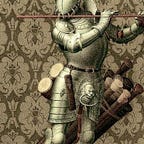Book Review: Marhi da Deeva (Punjabi) by Gurdial Singh
Marhi da deeva (ਮੜ੍ਹੀ ਦਾ ਦੀਵਾ) is a novel that grips you from the beginning and does not let you go, it makes you tremble as you read, and shaken when you’re finished.
Set in a vague post independence, pre liberalisation Punjab, (it was first published in 1964) it is the story of Jagseer (ਜਗਸੀਰ) and his mother, Nandi (ਨੰਦੀ).
The novel opens with a day in the life of an old, almost blind Nandi, desperately seeking human company with a neighbour, through the offered temptation of gossip. It is something, we learn, she does very often. The question of loneliness and the pursuit of companionship is a pervasive central theme in the novel.
The two pillars of Nandi’s small life are her middle aged son, Jagseer, unfortunately still unmarried. And the marhi (shrine of remembrance) dedicated to the memory of her dead husband – built under an old, sprawling talli tree, in the corner of a family plot.
This plot, owned by a kind Jat farmer, Dharam Singh (ਧਰਮ ਸਿੰਘ), had once been farmed by Nandi’s dead husband. Dharam Singh’s father and Nandi’s husband had been deep friends – but there was more to the relationship. While ‘friends’, Jagseer’s father and Dharam Singh’s were in a landlord-tenant relationship too – and the family plot, so tenderly reared by Jagseer, was, in a sense, remuneration for labour the ‘landless lower caste’ farmer performed for the Jatt landlord. One wonders if there was always more to the friendship. Such complex social and personal relations form the rich weave of intersecting lives in Marhi da Deeva.
It is tempting to read the novel only from the framework of social dynamics (as has most often been done), but the psychological evolution (or devolution – through drug addiction, or both) of Jagseer is the most powerfully gripping aspect. As I approached the end of the novel, as Jagseer reached a epiphanic stage in his life, I was reminded of another dynamic which plays throughout the plot – the relationship between maya and dukkha.
While the caste dynamic exists (pervasively) in the village, a young, physically strong and exuberant Jagseer – a flashback element of the story – is untouched by it. As, through drug addiction and the psychological weight of love-longing, his body weakens, he at once is made (implicitly and explicitly) more aware of his position in society.
Through this journey, Jagseer perhaps reaches a stage where the realisation of maya as the pervasive element of social life, the realisation of dukkha as an eternal truth, and the possibility of moments of happiness through friendship, companionship and love – leads him to a glimpse of moksha.
There is a lamp in the darkness to guide us across, after all.
–
Please subscribe to my newsletter to receive latest articles in your email inbox : https://sialmirzagoraya.substack.com
